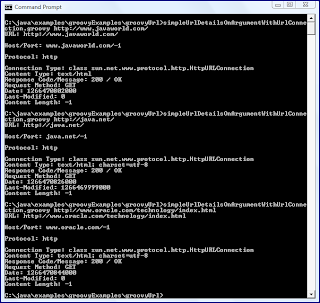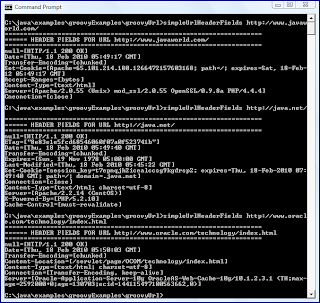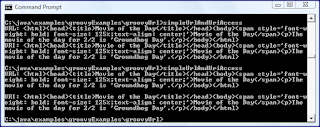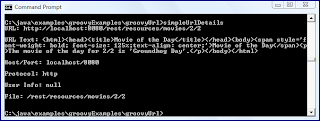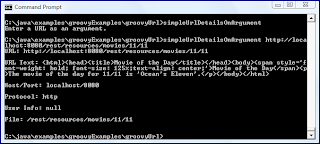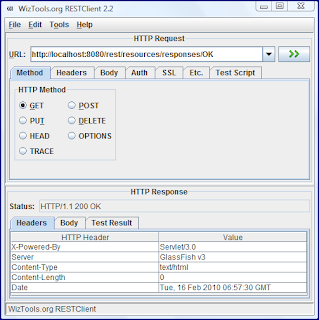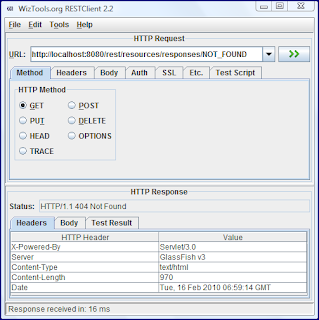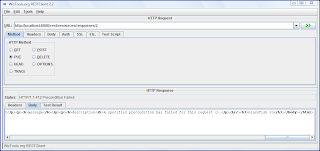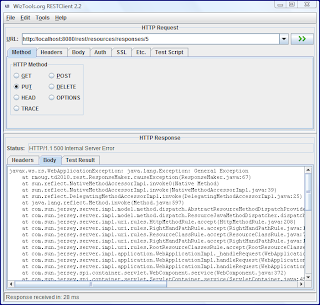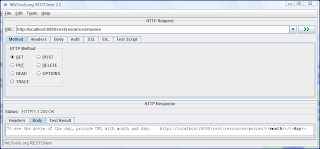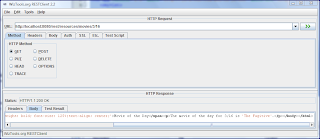Calendar may need to do is specify a particular TimeZone. The specification of a TimeZone is done via String-based TimeZone IDs. This blog post demonstrates getting these String-based IDs with both Java and Groovy.The
TimeZone class provides a static method for getting an array of the Strings representing recognized TimeZone IDs. The availability of this method, TimeZone.getAvailableIDs(), allows a developer to programmatically access TimeZone IDs supported by the current JRE release or via Timezone Updater. I have blogged previously on the value of using simple Java tests. The next code listing is an example of just that and provides the available set of TimeZone IDs for a given environment.TimeZoneIds.java
package dustin.examples;
import java.util.Arrays;
import java.util.TimeZone;
import static java.lang.System.out;
public class TimeZoneIds
{
public static void main(final String[] arguments)
{
out.println(Arrays.toString(TimeZone.getAvailableIDs()));
}
}
Compiling and running the above class results in output like the following:
[Etc/GMT+12, Etc/GMT+11, MIT, Pacific/Apia, Pacific/Midway, Pacific/Niue, Pacific/Pago_Pago, Pacific/Samoa, US/Samoa, America/Adak, America/Atka, Etc/GMT+10, HST, Pacific/Fakaofo, Pacific/Honolulu, Pacific/Johnston, Pacific/Rarotonga, Pacific/Tahiti, SystemV/HST10, US/Aleutian, US/Hawaii, Pacific/Marquesas, AST, America/Anchorage, America/Juneau, America/Nome, America/Yakutat, Etc/GMT+9, Pacific/Gambier, SystemV/YST9, SystemV/YST9YDT, US/Alaska, America/Dawson, America/Ensenada, America/Los_Angeles, America/Tijuana, America/Vancouver, America/Whitehorse, Canada/Pacific, Canada/Yukon, Etc/GMT+8, Mexico/BajaNorte, PST, PST8PDT, Pacific/Pitcairn, SystemV/PST8, SystemV/PST8PDT, US/Pacific, US/Pacific-New, America/Boise, America/Cambridge_Bay, America/Chihuahua, America/Dawson_Creek, America/Denver, America/Edmonton, America/Hermosillo, America/Inuvik, America/Mazatlan, America/Phoenix, America/Shiprock, America/Yellowknife, Canada/Mountain, Etc/GMT+7, MST, MST7MDT, Mexico/BajaSur, Navajo, PNT, SystemV/MST7, SystemV/MST7MDT, US/Arizona, US/Mountain, America/Belize, America/Cancun, America/Chicago, America/Costa_Rica, America/El_Salvador, America/Guatemala, America/Indiana/Knox, America/Indiana/Tell_City, America/Knox_IN, America/Managua, America/Menominee, America/Merida, America/Mexico_City, America/Monterrey, America/North_Dakota/Center, America/North_Dakota/New_Salem, America/Rainy_River, America/Rankin_Inlet, America/Regina, America/Swift_Current, America/Tegucigalpa, America/Winnipeg, CST, CST6CDT, Canada/Central, Canada/East-Saskatchewan, Canada/Saskatchewan, Chile/EasterIsland, Etc/GMT+6, Mexico/General, Pacific/Easter, Pacific/Galapagos, SystemV/CST6, SystemV/CST6CDT, US/Central, US/Indiana-Starke, America/Atikokan, America/Bogota, America/Cayman, America/Coral_Harbour, America/Detroit, America/Fort_Wayne, America/Grand_Turk, America/Guayaquil, America/Havana, America/Indiana/Indianapolis, America/Indiana/Marengo, America/Indiana/Petersburg, America/Indiana/Vevay, America/Indiana/Vincennes, America/Indiana/Winamac, America/Indianapolis, America/Iqaluit, America/Jamaica, America/Kentucky/Louisville, America/Kentucky/Monticello, America/Lima, America/Louisville, America/Montreal, America/Nassau, America/New_York, America/Nipigon, America/Panama, America/Pangnirtung, America/Port-au-Prince, America/Resolute, America/Thunder_Bay, America/Toronto, Canada/Eastern, Cuba, EST, EST5EDT, Etc/GMT+5, IET, Jamaica, SystemV/EST5, SystemV/EST5EDT, US/East-Indiana, US/Eastern, US/Michigan, America/Caracas, America/Anguilla, America/Antigua, America/Argentina/San_Luis, America/Aruba, America/Asuncion, America/Barbados, America/Blanc-Sablon, America/Boa_Vista, America/Campo_Grande, America/Cuiaba, America/Curacao, America/Dominica, America/Eirunepe, America/Glace_Bay, America/Goose_Bay, America/Grenada, America/Guadeloupe, America/Guyana, America/Halifax, America/La_Paz, America/Manaus, America/Marigot, America/Martinique, America/Moncton, America/Montserrat, America/Port_of_Spain, America/Porto_Acre, America/Porto_Velho, America/Puerto_Rico, America/Rio_Branco, America/Santiago, America/Santo_Domingo, America/St_Barthelemy, America/St_Kitts, America/St_Lucia, America/St_Thomas, America/St_Vincent, America/Thule, America/Tortola, America/Virgin, Antarctica/Palmer, Atlantic/Bermuda, Atlantic/Stanley, Brazil/Acre, Brazil/West, Canada/Atlantic, Chile/Continental, Etc/GMT+4, PRT, SystemV/AST4, SystemV/AST4ADT, America/St_Johns, CNT, Canada/Newfoundland, AGT, America/Araguaina, America/Argentina/Buenos_Aires, America/Argentina/Catamarca, America/Argentina/ComodRivadavia, America/Argentina/Cordoba, America/Argentina/Jujuy, America/Argentina/La_Rioja, America/Argentina/Mendoza, America/Argentina/Rio_Gallegos, America/Argentina/Salta, America/Argentina/San_Juan, America/Argentina/Tucuman, America/Argentina/Ushuaia, America/Bahia, America/Belem, America/Buenos_Aires, America/Catamarca, America/Cayenne, America/Cordoba, America/Fortaleza, America/Godthab, America/Jujuy, America/Maceio, America/Mendoza, America/Miquelon, America/Montevideo, America/Paramaribo, America/Recife, America/Rosario, America/Santarem, America/Sao_Paulo, Antarctica/Rothera, BET, Brazil/East, Etc/GMT+3, America/Noronha, Atlantic/South_Georgia, Brazil/DeNoronha, Etc/GMT+2, America/Scoresbysund, Atlantic/Azores, Atlantic/Cape_Verde, Etc/GMT+1, Africa/Abidjan, Africa/Accra, Africa/Bamako, Africa/Banjul, Africa/Bissau, Africa/Casablanca, Africa/Conakry, Africa/Dakar, Africa/El_Aaiun, Africa/Freetown, Africa/Lome, Africa/Monrovia, Africa/Nouakchott, Africa/Ouagadougou, Africa/Sao_Tome, Africa/Timbuktu, America/Danmarkshavn, Atlantic/Canary, Atlantic/Faeroe, Atlantic/Faroe, Atlantic/Madeira, Atlantic/Reykjavik, Atlantic/St_Helena, Eire, Etc/GMT, Etc/GMT+0, Etc/GMT-0, Etc/GMT0, Etc/Greenwich, Etc/UCT, Etc/UTC, Etc/Universal, Etc/Zulu, Europe/Belfast, Europe/Dublin, Europe/Guernsey, Europe/Isle_of_Man, Europe/Jersey, Europe/Lisbon, Europe/London, GB, GB-Eire, GMT, GMT0, Greenwich, Iceland, Portugal, UCT, UTC, Universal, WET, Zulu, Africa/Algiers, Africa/Bangui, Africa/Brazzaville, Africa/Ceuta, Africa/Douala, Africa/Kinshasa, Africa/Lagos, Africa/Libreville, Africa/Luanda, Africa/Malabo, Africa/Ndjamena, Africa/Niamey, Africa/Porto-Novo, Africa/Tunis, Africa/Windhoek, Arctic/Longyearbyen, Atlantic/Jan_Mayen, CET, ECT, Etc/GMT-1, Europe/Amsterdam, Europe/Andorra, Europe/Belgrade, Europe/Berlin, Europe/Bratislava, Europe/Brussels, Europe/Budapest, Europe/Copenhagen, Europe/Gibraltar, Europe/Ljubljana, Europe/Luxembourg, Europe/Madrid, Europe/Malta, Europe/Monaco, Europe/Oslo, Europe/Paris, Europe/Podgorica, Europe/Prague, Europe/Rome, Europe/San_Marino, Europe/Sarajevo, Europe/Skopje, Europe/Stockholm, Europe/Tirane, Europe/Vaduz, Europe/Vatican, Europe/Vienna, Europe/Warsaw, Europe/Zagreb, Europe/Zurich, MET, Poland, ART, Africa/Blantyre, Africa/Bujumbura, Africa/Cairo, Africa/Gaborone, Africa/Harare, Africa/Johannesburg, Africa/Kigali, Africa/Lubumbashi, Africa/Lusaka, Africa/Maputo, Africa/Maseru, Africa/Mbabane, Africa/Tripoli, Asia/Amman, Asia/Beirut, Asia/Damascus, Asia/Gaza, Asia/Istanbul, Asia/Jerusalem, Asia/Nicosia, Asia/Tel_Aviv, CAT, EET, Egypt, Etc/GMT-2, Europe/Athens, Europe/Bucharest, Europe/Chisinau, Europe/Helsinki, Europe/Istanbul, Europe/Kaliningrad, Europe/Kiev, Europe/Mariehamn, Europe/Minsk, Europe/Nicosia, Europe/Riga, Europe/Simferopol, Europe/Sofia, Europe/Tallinn, Europe/Tiraspol, Europe/Uzhgorod, Europe/Vilnius, Europe/Zaporozhye, Israel, Libya, Turkey, Africa/Addis_Ababa, Africa/Asmara, Africa/Asmera, Africa/Dar_es_Salaam, Africa/Djibouti, Africa/Kampala, Africa/Khartoum, Africa/Mogadishu, Africa/Nairobi, Antarctica/Syowa, Asia/Aden, Asia/Baghdad, Asia/Bahrain, Asia/Kuwait, Asia/Qatar, Asia/Riyadh, EAT, Etc/GMT-3, Europe/Moscow, Europe/Volgograd, Indian/Antananarivo, Indian/Comoro, Indian/Mayotte, W-SU, Asia/Riyadh87, Asia/Riyadh88, Asia/Riyadh89, Mideast/Riyadh87, Mideast/Riyadh88, Mideast/Riyadh89, Asia/Tehran, Iran, Asia/Baku, Asia/Dubai, Asia/Muscat, Asia/Tbilisi, Asia/Yerevan, Etc/GMT-4, Europe/Samara, Indian/Mahe, Indian/Mauritius, Indian/Reunion, NET, Asia/Kabul, Asia/Aqtau, Asia/Aqtobe, Asia/Ashgabat, Asia/Ashkhabad, Asia/Dushanbe, Asia/Karachi, Asia/Oral, Asia/Samarkand, Asia/Tashkent, Asia/Yekaterinburg, Etc/GMT-5, Indian/Kerguelen, Indian/Maldives, PLT, Asia/Calcutta, Asia/Colombo, Asia/Kolkata, IST, Asia/Kathmandu, Asia/Katmandu, Antarctica/Mawson, Antarctica/Vostok, Asia/Almaty, Asia/Bishkek, Asia/Dacca, Asia/Dhaka, Asia/Novosibirsk, Asia/Omsk, Asia/Qyzylorda, Asia/Thimbu, Asia/Thimphu, BST, Etc/GMT-6, Indian/Chagos, Asia/Rangoon, Indian/Cocos, Antarctica/Davis, Asia/Bangkok, Asia/Ho_Chi_Minh, Asia/Hovd, Asia/Jakarta, Asia/Krasnoyarsk, Asia/Phnom_Penh, Asia/Pontianak, Asia/Saigon, Asia/Vientiane, Etc/GMT-7, Indian/Christmas, VST, Antarctica/Casey, Asia/Brunei, Asia/Choibalsan, Asia/Chongqing, Asia/Chungking, Asia/Harbin, Asia/Hong_Kong, Asia/Irkutsk, Asia/Kashgar, Asia/Kuala_Lumpur, Asia/Kuching, Asia/Macao, Asia/Macau, Asia/Makassar, Asia/Manila, Asia/Shanghai, Asia/Singapore, Asia/Taipei, Asia/Ujung_Pandang, Asia/Ulaanbaatar, Asia/Ulan_Bator, Asia/Urumqi, Australia/Perth, Australia/West, CTT, Etc/GMT-8, Hongkong, PRC, Singapore, Australia/Eucla, Asia/Dili, Asia/Jayapura, Asia/Pyongyang, Asia/Seoul, Asia/Tokyo, Asia/Yakutsk, Etc/GMT-9, JST, Japan, Pacific/Palau, ROK, ACT, Australia/Adelaide, Australia/Broken_Hill, Australia/Darwin, Australia/North, Australia/South, Australia/Yancowinna, AET, Antarctica/DumontDUrville, Asia/Sakhalin, Asia/Vladivostok, Australia/ACT, Australia/Brisbane, Australia/Canberra, Australia/Currie, Australia/Hobart, Australia/Lindeman, Australia/Melbourne, Australia/NSW, Australia/Queensland, Australia/Sydney, Australia/Tasmania, Australia/Victoria, Etc/GMT-10, Pacific/Guam, Pacific/Port_Moresby, Pacific/Saipan, Pacific/Truk, Pacific/Yap, Australia/LHI, Australia/Lord_Howe, Asia/Magadan, Etc/GMT-11, Pacific/Efate, Pacific/Guadalcanal, Pacific/Kosrae, Pacific/Noumea, Pacific/Ponape, SST, Pacific/Norfolk, Antarctica/McMurdo, Antarctica/South_Pole, Asia/Anadyr, Asia/Kamchatka, Etc/GMT-12, Kwajalein, NST, NZ, Pacific/Auckland, Pacific/Fiji, Pacific/Funafuti, Pacific/Kwajalein, Pacific/Majuro, Pacific/Nauru, Pacific/Tarawa, Pacific/Wake, Pacific/Wallis, NZ-CHAT, Pacific/Chatham, Etc/GMT-13, Pacific/Enderbury, Pacific/Tongatapu, Etc/GMT-14, Pacific/Kiritimati]
The above Java code is relatively simple and it does the job of providing the valid TimeZone IDs available to me in a given environment, but Groovy can be even simpler to use in situations such as this one. The next code listing is a simple Groovy script for printing out these values.
displayTimeZoneIds1.groovy
println Arrays.toString(TimeZone.availableIDs)
Wow! It doesn't get much simpler than that. Groovy allowed me to drop the class declaration, the main method declaration, both java.util imports, and even simplified the "meaty" line from the Java code. It turns out that it actually does gets even easier, however, as shown in the next version of the Groovy-based script.
displayTimeZoneIds2.groovy
println TimeZone.availableIDs
The second version of the Groovy script dropped use of Arrays.toString(Object) because it is unnecessary when using Groovy arrays. Now that's super simple:
println TimeZone.availableIDsThe static method
Arrays.toString(Object[]) was necessary in the Java example to avoid seeing the default Object.toString() implementation for the array of Strings that would look something like this: [Ljava.lang.String;@3e25a5 where the [ indicates an array, the L indicates a reference type (not primitive), java.lang.String is obviously the class name of the elements of the array, and the @3e25a5 represents the "unsigned hexadecimal representation" of the object's hash code.With things so simple, it seems like it's a good time to add some additional functionality. We'll do one more very simple thing that will dramatically improve the readability of our output. The third version of the Groovy script leverages Groovy's closure support to easy iterate over the String array and print each element of the array (each TimeZone ID) on its own line and without the array delimiting square braces ([]).
displayTimeZoneIds3.groovy
TimeZone.availableIDs.each {println it}
It may seem almost too good to be true, but here's the output:
Etc/GMT+12
Etc/GMT+11
MIT
Pacific/Apia
Pacific/Midway
Pacific/Niue
Pacific/Pago_Pago
Pacific/Samoa
US/Samoa
America/Adak
America/Atka
Etc/GMT+10
HST
Pacific/Fakaofo
Pacific/Honolulu
Pacific/Johnston
Pacific/Rarotonga
Pacific/Tahiti
SystemV/HST10
US/Aleutian
US/Hawaii
Pacific/Marquesas
AST
America/Anchorage
America/Juneau
America/Nome
America/Yakutat
Etc/GMT+9
Pacific/Gambier
SystemV/YST9
SystemV/YST9YDT
US/Alaska
America/Dawson
America/Ensenada
America/Los_Angeles
America/Tijuana
America/Vancouver
America/Whitehorse
Canada/Pacific
Canada/Yukon
Etc/GMT+8
Mexico/BajaNorte
PST
PST8PDT
Pacific/Pitcairn
SystemV/PST8
SystemV/PST8PDT
US/Pacific
US/Pacific-New
America/Boise
America/Cambridge_Bay
America/Chihuahua
America/Dawson_Creek
America/Denver
America/Edmonton
America/Hermosillo
America/Inuvik
America/Mazatlan
America/Phoenix
America/Shiprock
America/Yellowknife
Canada/Mountain
Etc/GMT+7
MST
MST7MDT
Mexico/BajaSur
Navajo
PNT
SystemV/MST7
SystemV/MST7MDT
US/Arizona
US/Mountain
America/Belize
America/Cancun
America/Chicago
America/Costa_Rica
America/El_Salvador
America/Guatemala
America/Indiana/Knox
America/Indiana/Tell_City
America/Knox_IN
America/Managua
America/Menominee
America/Merida
America/Mexico_City
America/Monterrey
America/North_Dakota/Center
America/North_Dakota/New_Salem
America/Rainy_River
America/Rankin_Inlet
America/Regina
America/Swift_Current
America/Tegucigalpa
America/Winnipeg
CST
CST6CDT
Canada/Central
Canada/East-Saskatchewan
Canada/Saskatchewan
Chile/EasterIsland
Etc/GMT+6
Mexico/General
Pacific/Easter
Pacific/Galapagos
SystemV/CST6
SystemV/CST6CDT
US/Central
US/Indiana-Starke
America/Atikokan
America/Bogota
America/Cayman
America/Coral_Harbour
America/Detroit
America/Fort_Wayne
America/Grand_Turk
America/Guayaquil
America/Havana
America/Indiana/Indianapolis
America/Indiana/Marengo
America/Indiana/Petersburg
America/Indiana/Vevay
America/Indiana/Vincennes
America/Indiana/Winamac
America/Indianapolis
America/Iqaluit
America/Jamaica
America/Kentucky/Louisville
America/Kentucky/Monticello
America/Lima
America/Louisville
America/Montreal
America/Nassau
America/New_York
America/Nipigon
America/Panama
America/Pangnirtung
America/Port-au-Prince
America/Resolute
America/Thunder_Bay
America/Toronto
Canada/Eastern
Cuba
EST
EST5EDT
Etc/GMT+5
IET
Jamaica
SystemV/EST5
SystemV/EST5EDT
US/East-Indiana
US/Eastern
US/Michigan
America/Caracas
America/Anguilla
America/Antigua
America/Argentina/San_Luis
America/Aruba
America/Asuncion
America/Barbados
America/Blanc-Sablon
America/Boa_Vista
America/Campo_Grande
America/Cuiaba
America/Curacao
America/Dominica
America/Eirunepe
America/Glace_Bay
America/Goose_Bay
America/Grenada
America/Guadeloupe
America/Guyana
America/Halifax
America/La_Paz
America/Manaus
America/Marigot
America/Martinique
America/Moncton
America/Montserrat
America/Port_of_Spain
America/Porto_Acre
America/Porto_Velho
America/Puerto_Rico
America/Rio_Branco
America/Santiago
America/Santo_Domingo
America/St_Barthelemy
America/St_Kitts
America/St_Lucia
America/St_Thomas
America/St_Vincent
America/Thule
America/Tortola
America/Virgin
Antarctica/Palmer
Atlantic/Bermuda
Atlantic/Stanley
Brazil/Acre
Brazil/West
Canada/Atlantic
Chile/Continental
Etc/GMT+4
PRT
SystemV/AST4
SystemV/AST4ADT
America/St_Johns
CNT
Canada/Newfoundland
AGT
America/Araguaina
America/Argentina/Buenos_Aires
America/Argentina/Catamarca
America/Argentina/ComodRivadavia
America/Argentina/Cordoba
America/Argentina/Jujuy
America/Argentina/La_Rioja
America/Argentina/Mendoza
America/Argentina/Rio_Gallegos
America/Argentina/Salta
America/Argentina/San_Juan
America/Argentina/Tucuman
America/Argentina/Ushuaia
America/Bahia
America/Belem
America/Buenos_Aires
America/Catamarca
America/Cayenne
America/Cordoba
America/Fortaleza
America/Godthab
America/Jujuy
America/Maceio
America/Mendoza
America/Miquelon
America/Montevideo
America/Paramaribo
America/Recife
America/Rosario
America/Santarem
America/Sao_Paulo
Antarctica/Rothera
BET
Brazil/East
Etc/GMT+3
America/Noronha
Atlantic/South_Georgia
Brazil/DeNoronha
Etc/GMT+2
America/Scoresbysund
Atlantic/Azores
Atlantic/Cape_Verde
Etc/GMT+1
Africa/Abidjan
Africa/Accra
Africa/Bamako
Africa/Banjul
Africa/Bissau
Africa/Casablanca
Africa/Conakry
Africa/Dakar
Africa/El_Aaiun
Africa/Freetown
Africa/Lome
Africa/Monrovia
Africa/Nouakchott
Africa/Ouagadougou
Africa/Sao_Tome
Africa/Timbuktu
America/Danmarkshavn
Atlantic/Canary
Atlantic/Faeroe
Atlantic/Faroe
Atlantic/Madeira
Atlantic/Reykjavik
Atlantic/St_Helena
Eire
Etc/GMT
Etc/GMT+0
Etc/GMT-0
Etc/GMT0
Etc/Greenwich
Etc/UCT
Etc/UTC
Etc/Universal
Etc/Zulu
Europe/Belfast
Europe/Dublin
Europe/Guernsey
Europe/Isle_of_Man
Europe/Jersey
Europe/Lisbon
Europe/London
GB
GB-Eire
GMT
GMT0
Greenwich
Iceland
Portugal
UCT
UTC
Universal
WET
Zulu
Africa/Algiers
Africa/Bangui
Africa/Brazzaville
Africa/Ceuta
Africa/Douala
Africa/Kinshasa
Africa/Lagos
Africa/Libreville
Africa/Luanda
Africa/Malabo
Africa/Ndjamena
Africa/Niamey
Africa/Porto-Novo
Africa/Tunis
Africa/Windhoek
Arctic/Longyearbyen
Atlantic/Jan_Mayen
CET
ECT
Etc/GMT-1
Europe/Amsterdam
Europe/Andorra
Europe/Belgrade
Europe/Berlin
Europe/Bratislava
Europe/Brussels
Europe/Budapest
Europe/Copenhagen
Europe/Gibraltar
Europe/Ljubljana
Europe/Luxembourg
Europe/Madrid
Europe/Malta
Europe/Monaco
Europe/Oslo
Europe/Paris
Europe/Podgorica
Europe/Prague
Europe/Rome
Europe/San_Marino
Europe/Sarajevo
Europe/Skopje
Europe/Stockholm
Europe/Tirane
Europe/Vaduz
Europe/Vatican
Europe/Vienna
Europe/Warsaw
Europe/Zagreb
Europe/Zurich
MET
Poland
ART
Africa/Blantyre
Africa/Bujumbura
Africa/Cairo
Africa/Gaborone
Africa/Harare
Africa/Johannesburg
Africa/Kigali
Africa/Lubumbashi
Africa/Lusaka
Africa/Maputo
Africa/Maseru
Africa/Mbabane
Africa/Tripoli
Asia/Amman
Asia/Beirut
Asia/Damascus
Asia/Gaza
Asia/Istanbul
Asia/Jerusalem
Asia/Nicosia
Asia/Tel_Aviv
CAT
EET
Egypt
Etc/GMT-2
Europe/Athens
Europe/Bucharest
Europe/Chisinau
Europe/Helsinki
Europe/Istanbul
Europe/Kaliningrad
Europe/Kiev
Europe/Mariehamn
Europe/Minsk
Europe/Nicosia
Europe/Riga
Europe/Simferopol
Europe/Sofia
Europe/Tallinn
Europe/Tiraspol
Europe/Uzhgorod
Europe/Vilnius
Europe/Zaporozhye
Israel
Libya
Turkey
Africa/Addis_Ababa
Africa/Asmara
Africa/Asmera
Africa/Dar_es_Salaam
Africa/Djibouti
Africa/Kampala
Africa/Khartoum
Africa/Mogadishu
Africa/Nairobi
Antarctica/Syowa
Asia/Aden
Asia/Baghdad
Asia/Bahrain
Asia/Kuwait
Asia/Qatar
Asia/Riyadh
EAT
Etc/GMT-3
Europe/Moscow
Europe/Volgograd
Indian/Antananarivo
Indian/Comoro
Indian/Mayotte
W-SU
Asia/Riyadh87
Asia/Riyadh88
Asia/Riyadh89
Mideast/Riyadh87
Mideast/Riyadh88
Mideast/Riyadh89
Asia/Tehran
Iran
Asia/Baku
Asia/Dubai
Asia/Muscat
Asia/Tbilisi
Asia/Yerevan
Etc/GMT-4
Europe/Samara
Indian/Mahe
Indian/Mauritius
Indian/Reunion
NET
Asia/Kabul
Asia/Aqtau
Asia/Aqtobe
Asia/Ashgabat
Asia/Ashkhabad
Asia/Dushanbe
Asia/Karachi
Asia/Oral
Asia/Samarkand
Asia/Tashkent
Asia/Yekaterinburg
Etc/GMT-5
Indian/Kerguelen
Indian/Maldives
PLT
Asia/Calcutta
Asia/Colombo
Asia/Kolkata
IST
Asia/Kathmandu
Asia/Katmandu
Antarctica/Mawson
Antarctica/Vostok
Asia/Almaty
Asia/Bishkek
Asia/Dacca
Asia/Dhaka
Asia/Novosibirsk
Asia/Omsk
Asia/Qyzylorda
Asia/Thimbu
Asia/Thimphu
BST
Etc/GMT-6
Indian/Chagos
Asia/Rangoon
Indian/Cocos
Antarctica/Davis
Asia/Bangkok
Asia/Ho_Chi_Minh
Asia/Hovd
Asia/Jakarta
Asia/Krasnoyarsk
Asia/Phnom_Penh
Asia/Pontianak
Asia/Saigon
Asia/Vientiane
Etc/GMT-7
Indian/Christmas
VST
Antarctica/Casey
Asia/Brunei
Asia/Choibalsan
Asia/Chongqing
Asia/Chungking
Asia/Harbin
Asia/Hong_Kong
Asia/Irkutsk
Asia/Kashgar
Asia/Kuala_Lumpur
Asia/Kuching
Asia/Macao
Asia/Macau
Asia/Makassar
Asia/Manila
Asia/Shanghai
Asia/Singapore
Asia/Taipei
Asia/Ujung_Pandang
Asia/Ulaanbaatar
Asia/Ulan_Bator
Asia/Urumqi
Australia/Perth
Australia/West
CTT
Etc/GMT-8
Hongkong
PRC
Singapore
Australia/Eucla
Asia/Dili
Asia/Jayapura
Asia/Pyongyang
Asia/Seoul
Asia/Tokyo
Asia/Yakutsk
Etc/GMT-9
JST
Japan
Pacific/Palau
ROK
ACT
Australia/Adelaide
Australia/Broken_Hill
Australia/Darwin
Australia/North
Australia/South
Australia/Yancowinna
AET
Antarctica/DumontDUrville
Asia/Sakhalin
Asia/Vladivostok
Australia/ACT
Australia/Brisbane
Australia/Canberra
Australia/Currie
Australia/Hobart
Australia/Lindeman
Australia/Melbourne
Australia/NSW
Australia/Queensland
Australia/Sydney
Australia/Tasmania
Australia/Victoria
Etc/GMT-10
Pacific/Guam
Pacific/Port_Moresby
Pacific/Saipan
Pacific/Truk
Pacific/Yap
Australia/LHI
Australia/Lord_Howe
Asia/Magadan
Etc/GMT-11
Pacific/Efate
Pacific/Guadalcanal
Pacific/Kosrae
Pacific/Noumea
Pacific/Ponape
SST
Pacific/Norfolk
Antarctica/McMurdo
Antarctica/South_Pole
Asia/Anadyr
Asia/Kamchatka
Etc/GMT-12
Kwajalein
NST
NZ
Pacific/Auckland
Pacific/Fiji
Pacific/Funafuti
Pacific/Kwajalein
Pacific/Majuro
Pacific/Nauru
Pacific/Tarawa
Pacific/Wake
Pacific/Wallis
NZ-CHAT
Pacific/Chatham
Etc/GMT-13
Pacific/Enderbury
Pacific/Tongatapu
Etc/GMT-14
Pacific/Kiritimati
Before finishing this example, I would like to do one more thing to make the returned set of TimeZone IDs easier to manage. It can be difficult to find what I'm looking for in this list and I'd rather see it in sorted form.
displayTimeZoneIds4.groovy
TimeZone.availableIDs.sort().each {println it}
That's all there is to it -- there's nothing sordid about that. I don't show it here, but running that single line script will return the available TimeZone IDs without the array syntax, with each ID on its own line, in an alphabetically sorted order.
Conclusion
This blog post had two primary purposes. One purpose was to demonstrate another practical example of where Groovy can greatly simplify use of basic Java APIs, especially when simply trying to learn about something new or get a listing of options available in a given environment. A second purpose was to demonstrate how to find out which TimeZone IDs are available, though this was really more of an excuse to demonstrate the sleekness of Groovy.
